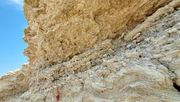Calculating Fill Volume w/ Laser Level
In this post I show how to estimate amount of fill needed for subgrade fill using a laser level. These instructions assume you are about ready to start work on foundation footings and are trying to determine how much subgrade base material (gravel) to haul in.
Worked Example for 5 Station Stakes

Step-by-Step Instructions
0.) How much fill do you need?
Commonly, you haul in gravel or D1 base in order to firm up the subgrade surface prior to forming up footings. Something like 5" to 10" of gravel fill. For this example, we'll use 10" as a minimum fill thickness (X).
1.) Mark out project boundary
Spray paint a neat box around the footprint of your building. If it were me, I would go 5 feet beyond the actual footprint as best you can determine it at this point. The boundary need not be perfect, but give it your best shot. Cheap spray paint works just a well as the stuff sold as "marking paint". I prefer white or orange.

2.) Layout grid with spray paint
For a smallish project like a garage, space the gridlines about 5 feet apart. For this example, we'll use a project area of 20' x 20' (400 sqft). Walk straight as you spray. Watch out for your shoes. Drive a wooden lath (stake) at every intersection in the grid. Clearly number each stake with a Sharpie. Be logical about the numbering system (Good = A,B,C; Bad = A, 2, e10, bingo).

3.) Set up laser on tripod
Set up the laser level base unit on its tripod at an average height (3 to 4 feet). Make sure nothing interferes with the line-of-sight between the laser and all stakes in your grid.

4.) Set up rover/beeper on stick
Find a straight stick with a flat bottom that is a couple feet longer than the height your base unit is above the ground as it sits on the tripod. A 2x3 works well. Clamp the rover/beeper unit to this stick. Once you start collecting measurements, don't unclamp or shift it around.

5.) Prepare datasheet
Find a pad of paper and pencil. Make a simple two-column datasheet with columns for "Station #" and "Measurement".
6.) Find a friend
Get a buddy to help you with the next step. A sober buddy will typically be more helpful, but this is not a hard and fast rule. North of 60 degrees latitude, the rules change.

7.) Get this stuff ready: Beeper stick, Tape measure, Sharpie, Datasheet, Pencil
Occupy the stake at Station #1. Raise/lower the stick to find the level line (beep indicates level). Have your buddy measure distance from the bottom of stick to ground surface at the stake. Record this value to the nearest 1/2" on your datasheet. Draw a horizontal line on the stake at this same elevation. Be neat about it.
8.) Repeat
Occupy all stations, recording and marking the level-line height measurement at each.

9.) Do the math
See example spreadsheet below for calculations you need to make. The smallest measured height is an important number (9" in the example, below). This represents the high spot in your project area grid. The minimum desired fill is the other important number (X = 10" in example).
10.) How many measurements do I need to be sure?
Assuming the rough grading across your project area is sort of flat and not crazy lumpy, then a grid spacing of 3 to 5 feet will do a good job of estimating the fill volume needed.

11.) Calculations
Find Avg Depth: 81/5 = 16.2, so 16.2" is the average fill depth needed across the project area
Project area = 400 square feet
Convert inches to feet: 16.2 inches = 1.35 feet
Volume: 20 x 20 x 1.35 = 933,120 cubic inches = 540 cubic feet = 20.0 cubic yards























